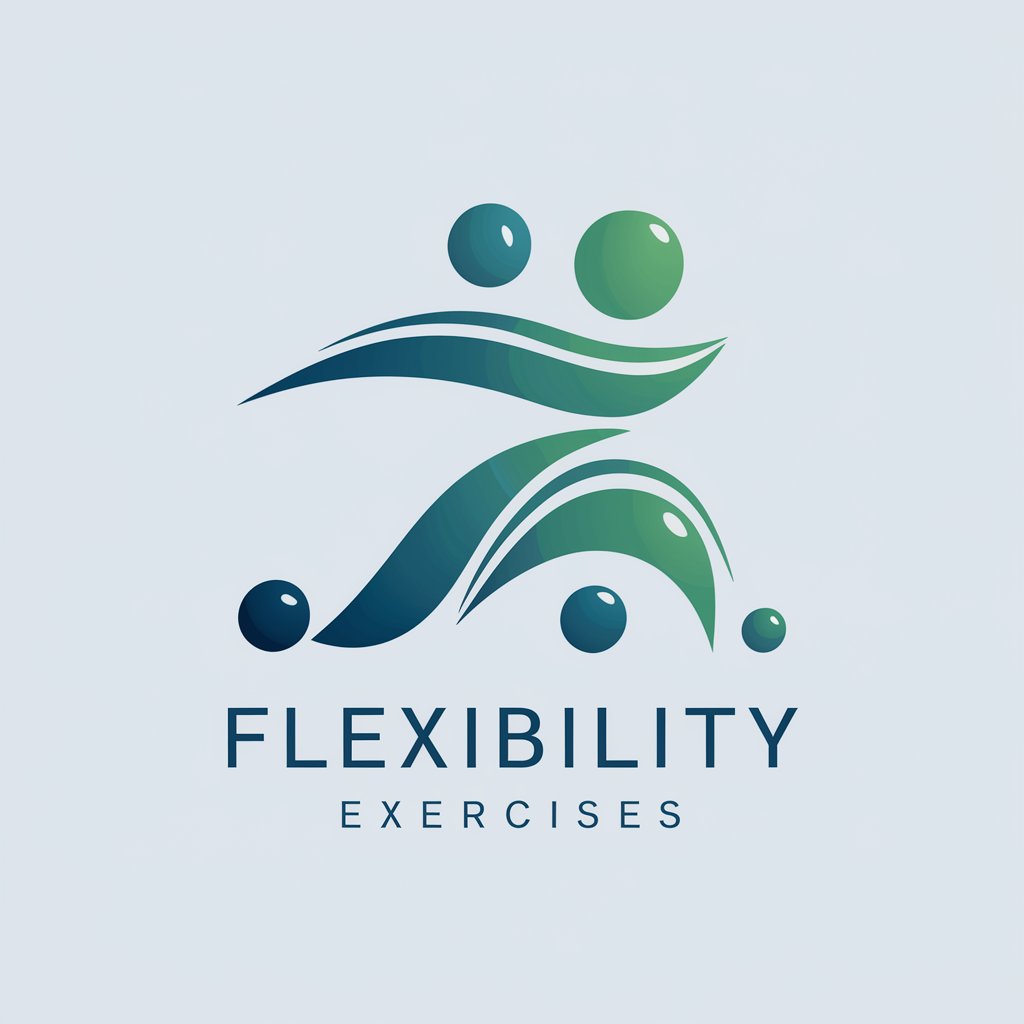Flexibility and mobility exercises - Custom Flexibility Training

Hello! Ready to enhance your flexibility and mobility?
Empowering movement, enhancing life
Describe your current range of motion and flexibility.
Mention any particular body parts or areas you'd like to focus on.
Specify what you aim to achieve with flexibility exercises.
List any previous or current injuries or conditions that might affect mobility work.
Get Embed Code
Introduction to Flexibility and Mobility Exercises
Flexibility and mobility exercises are designed to enhance the range of motion in joints and muscles, improve body posture, and promote overall physical well-being. The primary goal of these exercises is to increase the elasticity of muscles and tendons, and to improve the movement capabilities of joints, enabling individuals to perform daily activities and athletic endeavors with greater ease and less risk of injury. Examples of flexibility exercises include static stretches like the hamstring stretch, where one reaches forward to touch their toes, aiming to elongate the muscles at the back of the thigh. Mobility exercises, on the other hand, focus on dynamic movements that increase joint range, such as leg swings, which prepare the hip joint for a wide range of motion. These exercises are vital in a variety of scenarios, from rehabilitation settings, where they aid in the recovery and strengthening of injured areas, to athletic training, where they enhance performance and prevent injury. Powered by ChatGPT-4o。

Main Functions of Flexibility and Mobility Exercises
Enhancing Range of Motion
Example
Practicing lunges with a twist to improve hip and spine mobility.
Scenario
Used by runners and cyclists to prevent hip stiffness and lower back pain caused by repetitive movements.
Improving Posture
Example
Incorporating exercises like the chest opener and shoulder stretches.
Scenario
Beneficial for individuals with desk jobs to counteract the effects of prolonged sitting and reduce the risk of chronic back issues.
Reducing Injury Risk
Example
Dynamic warm-ups before physical activity, including leg swings and arm circles.
Scenario
Athletes perform these to prepare their bodies for the demands of their sport, minimizing the chance of sprains and strains.
Aiding Rehabilitation
Example
Gentle stretching routines for areas recovering from injury, tailored to gradually restore movement.
Scenario
Used in physical therapy settings to assist patients in regaining function after injuries like ACL tears or ankle sprains.
Promoting Relaxation and Stress Relief
Example
Yoga sequences that combine flexibility and mobility work with mindful breathing.
Scenario
Practiced by individuals looking to reduce mental stress and physical tension, enhancing overall wellness.
Ideal Users of Flexibility and Mobility Exercises
Athletes and Sports Enthusiasts
This group includes individuals engaged in any form of athletic activity, from amateur joggers to professional athletes. They benefit from tailored flexibility and mobility routines that enhance performance, prevent injury, and support recovery from the physical demands of their sports.
Rehabilitation Patients
Individuals recovering from injuries or surgery are ideal users of these exercises. Customized flexibility and mobility routines can help restore function, improve recovery outcomes, and speed up the return to daily activities or sports.
Office Workers and Individuals with Sedentary Lifestyles
This group benefits from exercises that counteract the effects of prolonged sitting, such as reduced hip mobility and poor posture, thereby preventing chronic pain and improving overall physical health.
Older Adults
Aging populations can maintain or improve their range of motion, balance, and independence through regular flexibility and mobility exercises, reducing the risk of falls and improving quality of life.
Individuals Seeking Stress Relief and Mental Wellness
People looking to enhance their mental well-being through physical activity can find relaxation and stress relief through the mindful practice of flexibility and mobility exercises, which often incorporate elements of meditation and focused breathing.

How to Use Flexibility and Mobility Exercises
1
Start your journey at yeschat.ai for a complimentary experience, no sign-up or ChatGPT Plus required.
2
Identify specific areas you want to improve, such as tight hamstrings or stiff shoulders, to focus your exercise routine.
3
Incorporate a mix of warm-up routines, targeted stretching exercises, and mobility drills into your weekly schedule, aiming for consistency.
4
Apply tips for safe stretching to avoid injury and ensure effective practice, including not overstretching and maintaining proper form.
5
Use progress tracking methods, such as a flexibility diary or apps, to monitor your improvements and adjust your routine accordingly.
Try other advanced and practical GPTs
Audience Analysis Analyst
Customizing Engagement with AI Power

You Grow Planner
Grow smarter with AI-powered planning

'Great Expectations' by Charles Dickens
Bringing Dickens to life with AI-powered immersion.

SEO GPT
Optimize your site's SEO with AI-driven insights

Music Business GPT
Empowering your music business journey with AI-driven insights.

GoodPoeT
Versify your voice with AI-powered poetry.

OTFAIO - Final Project Guide Maker
Empowering Educators with AI-Driven Curriculum Tools

Brand Strategist
Empowering Your Brand with AI

Manage my Expectations
AI-Powered Goal Structuring

World Seed Bank
Discover Your Perfect Minecraft World

Seed
Empowering your queries with AI

Seed Crafter
Craft Your Perfect Minecraft World

Flexibility and Mobility Exercises FAQ
What are flexibility and mobility exercises?
Flexibility and mobility exercises are designed to enhance the range of motion in your joints and muscles, improve posture, reduce the risk of injuries, and increase overall physical performance by incorporating stretching and movement patterns.
How often should I do flexibility exercises?
For best results, incorporate flexibility exercises into your routine 3-5 times per week, with at least one day of rest between sessions to allow for muscle recovery.
Can flexibility exercises help reduce back pain?
Yes, targeted flexibility exercises can help alleviate back pain by strengthening and stretching the back muscles, improving posture, and enhancing spinal mobility.
What is the difference between dynamic and static stretching?
Dynamic stretching involves active movements where joints and muscles go through a full range of motion, used primarily as a warm-up. Static stretching entails holding a stretch for a period, usually 15-60 seconds, to increase flexibility.
Are there any contraindications for flexibility exercises?
Individuals with recent or acute injuries, certain medical conditions, or those recovering from surgery should consult a healthcare professional before starting a flexibility and mobility exercise regimen.
